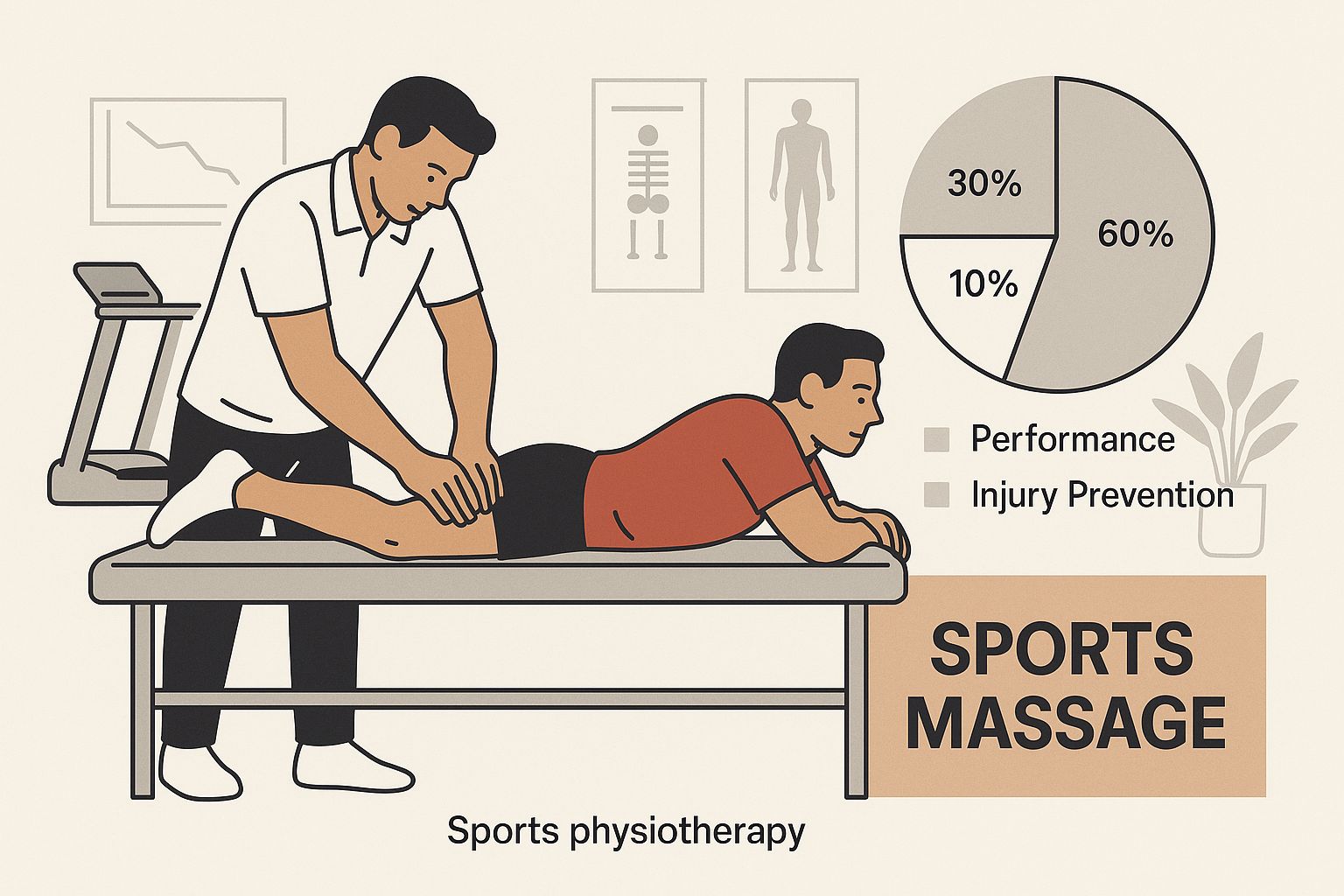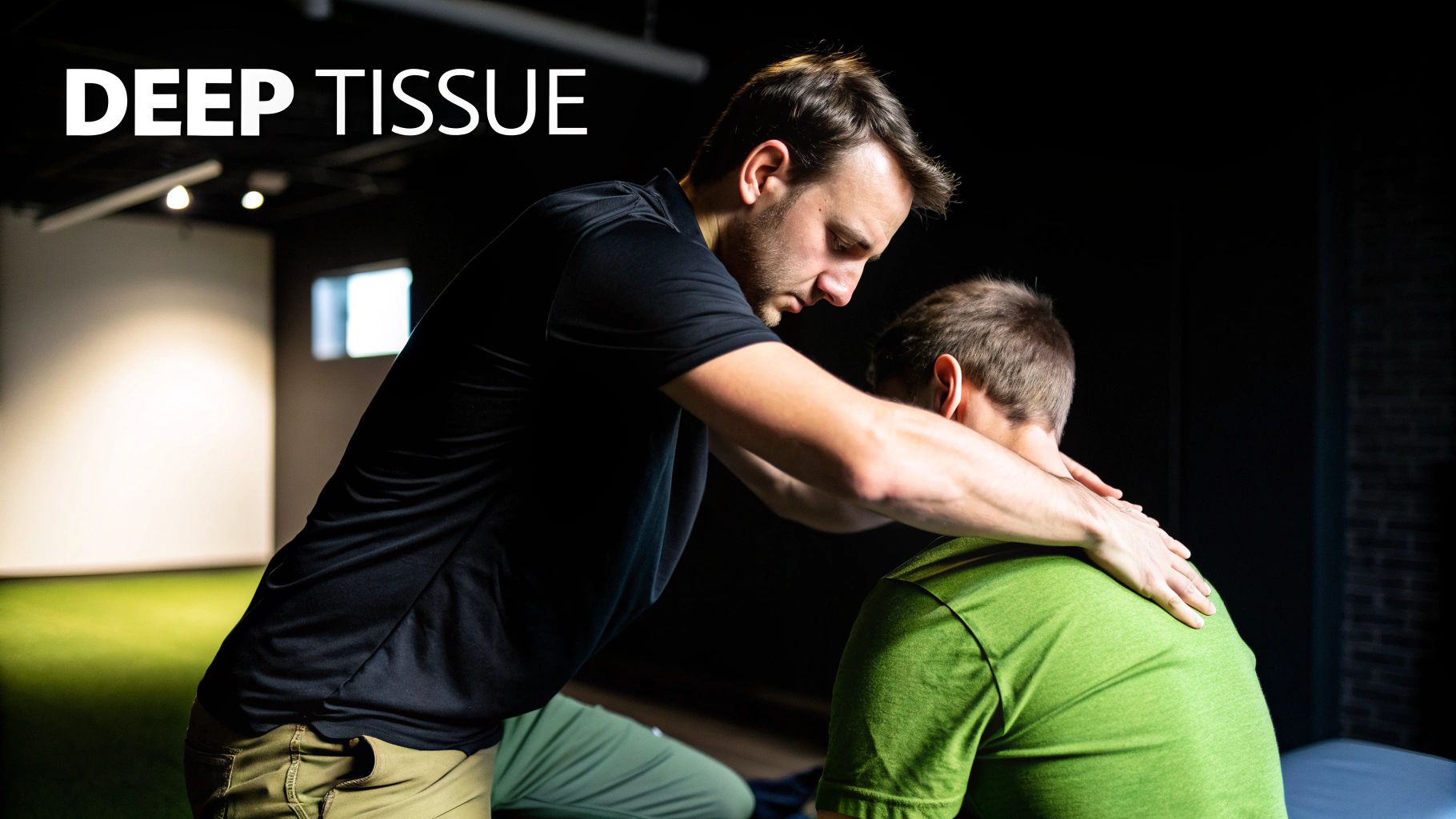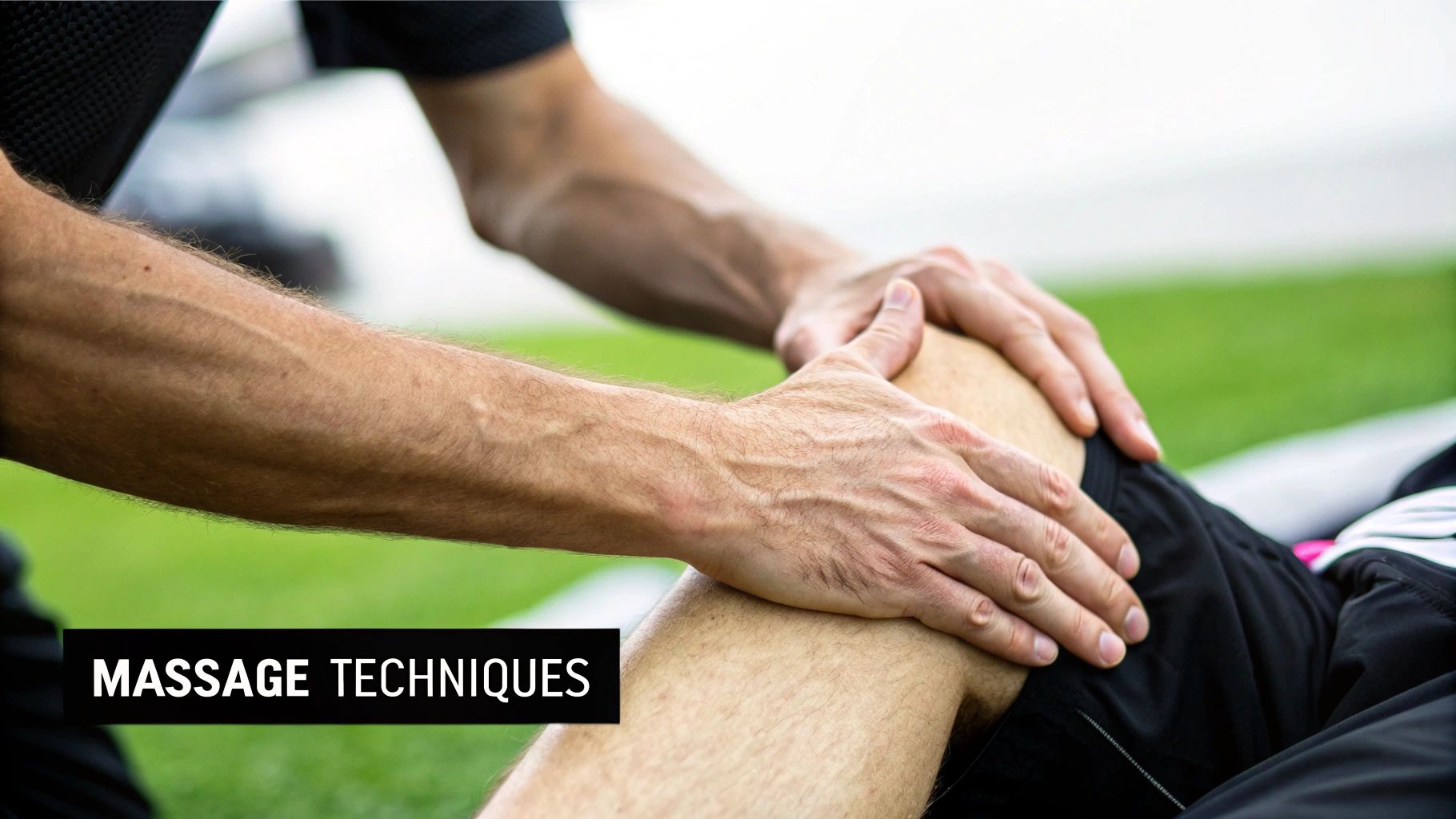Difference Between Sports Massage and Deep Tissue: Key Comparison

So, what's the real difference between a sports massage and a deep tissue massage? It really boils down to one simple question: are you trying to improve your athletic performance, or are you trying to get rid of nagging, chronic pain?
While both feel intense and get into the deeper layers of muscle, their goals are worlds apart. Think of it this way: a sports massage is a highly specialized tool for an athlete's body, while a deep tissue massage is a more universal solution for deep-seated tension anyone might experience.
Sports Massage vs. Deep Tissue: Which Is Right For You?
The core difference is all about intent. Sports massage was born out of the athletic world to help prevent injuries, prepare the body for intense activity, and speed up recovery. It zeroes in on the specific muscles you use for your particular sport.
On the other hand, deep tissue massage is designed to tackle chronic pain and stiffness—that nagging lower back ache from sitting at a desk or the tension in your shoulders that never seems to go away. It uses sustained, firm pressure to release those stubborn knots. For a deeper dive into their unique applications, you can learn more about the distinctions between sports and deep tissue massage.
This image perfectly captures the essence of a sports massage—it’s not just a general rubdown, but a targeted treatment focused on a specific muscle group to aid an athlete's recovery.

As you can see, sports massage is an integral part of a structured training and recovery regimen.
Here’s the simplest way I can put it: A sports massage therapist asks, "What activity are you training for?" A deep tissue therapist asks, "Where have you been hurting, and for how long?"
To help you decide, let's lay out the key differences side-by-side.
Sports Massage vs Deep Tissue Quick Comparison
Here's a quick cheat sheet to help you see the differences at a glance.
| Characteristic | Sports Massage | Deep Tissue Massage |
|---|---|---|
| Primary Goal | Enhance performance, prevent injury, and accelerate recovery. | Relieve chronic pain, break down adhesions, and improve posture. |
| Typical Use Case | Pre-event warm-up, post-event recovery, or training maintenance. | Persistent lower back pain, tension headaches, or stiff neck and shoulders. |
| Pressure & Style | Varies—can be fast and stimulating or slow and deep with stretching. | Slow, deliberate, and sustained firm pressure on deep muscle layers. |
| Ideal Frequency | Often weekly or bi-weekly during peak training seasons. | Usually every 2-4 weeks to manage chronic issues and allow for healing. |
Ultimately, this table highlights that your choice depends entirely on your immediate needs—whether that’s preparing for a marathon or finding relief from daily aches and pains.
Understanding the Purpose Behind Each Massage
To truly get to the heart of the sports massage vs. deep tissue debate, you have to look past the techniques and ask one simple question: What's the goal? They each answer a very different call from your body. One is all about function and performance, while the other is focused squarely on resolving chronic pain and tension.

The entire philosophy of a sports massage is woven into an athlete’s training cycle. It's not a one-off treat; it’s a strategic part of a bigger plan. The main objectives are prepping the body for intense effort, speeding up recovery after a big event, and keeping muscles healthy to sidestep injuries down the road.
Functional Performance vs. Therapeutic Relief
Think of sports massage therapy as a proactive tool you use to boost your physical potential. A marathon runner, for instance, might get a quick, stimulating massage before a race to wake up their leg muscles. After they cross the finish line, they’d get a different, more restorative massage to help flush out metabolic waste and ease soreness. The application is always tied to a specific athletic goal.
Deep tissue massage, on the other hand, comes from a place of therapeutic relief. Its job is to tackle chronic problems like that nagging lower back pain from sitting at a desk all day, postural misalignments, or stubborn knots—what we call adhesions—that have settled in over months or years. Here, the aim isn't about running faster; it's about restoring comfort and normal movement to muscles that have been causing you trouble.
Here's the key takeaway: Sports massage is part of a training regimen to optimize how your body performs. Deep tissue massage is a targeted solution for long-term pain and deep-seated muscle tension, whether you're an athlete or not.
This difference in purpose really dictates who benefits most. While anyone can get a sports massage, it's typically used by athletes and highly active people as a regular part of their routine. You can learn more about why sports massage therapy is your recovery game-changer in our dedicated guide.
Conversely, deep tissue massage serves a much wider crowd. It's for the office worker with stiff shoulders, the weekend warrior with a persistent hamstring issue, or anyone dealing with chronic aches. Your choice really boils down to whether your objective is performance-driven or pain-related.
Comparing Massage Techniques and Application
When you’re actually on the massage table, the hands-on differences between sports massage and deep tissue become crystal clear. One feels like a focused, dynamic tune-up for your muscles, while the other is more of a slow, methodical mission to release deeply ingrained tension. The entire experience is dictated by the end goal.

A sports massage session is almost never a passive experience. Your therapist will likely use a whole toolkit of techniques, sometimes in quick succession, to either prepare your muscles for action or help them recover afterward.
- Active Engagement: This is a big one. It often involves assisted stretching, where the therapist guides your limbs through specific ranges of motion to boost flexibility.
- Varied Strokes: You might experience brisk, stimulating strokes (tapotement) to wake up muscles before an event, or targeted friction applied directly to a stubborn adhesion.
- Dynamic Application: The pressure and speed are constantly adjusted based on where you are in your training cycle. It’s an active, collaborative process.
Methodical Strokes Versus Dynamic Movement
Deep tissue massage, on the other hand, is all about its slow, deliberate pace. The therapist applies sustained, intense pressure—often using their knuckles, forearms, or even elbows—to access those deeper layers of muscle and fascia. The aim isn't to energize the muscles, but to methodically "melt" away the chronic knots and adhesions that cause pain and limit your movement.
The core technical difference is this: Sports massage uses varied, active techniques tailored to an athletic function. Deep tissue massage uses slow, sustained pressure to resolve deep, chronic tension patterns.
While both can feel intense, the sensation itself is quite different. A sports massage might have brief, sharp moments of discomfort during friction or stretching, but it's part of a constantly changing sequence. Deep tissue maintains a consistent, firm pressure on specific trouble spots until they release. This distinction is crucial; it’s not just a regular massage with more oomph.
For a deeper dive into these nuances, check out our guide on sports massage vs regular massage. Ultimately, the how of each massage directly serves its unique purpose—one is for performance, the other is for chronic pain relief.
What Results Can You Actually Expect?
When you’re trying to choose between these two powerful therapies, it’s all about knowing what you want to achieve. Both will help ease tight muscles, but the tangible results they deliver are worlds apart. This is where the difference between sports massage and deep tissue really comes into focus.
Think of a sports massage as a tune-up for your body, with results geared toward performance and recovery. You’ll walk away with a noticeable improvement in flexibility and range of motion in the specific muscles that were worked on. But for most athletes, its biggest win is how it helps you bounce back after training.
Recovery Enhancement vs. Chronic Pain Relief
For anyone dealing with the fallout from intense activity, a sports massage can be a game-changer. It’s fantastic for healing athletic injuries like shin splints and actively reduces the misery of delayed onset muscle soreness (DOMS)—that all-too-familiar ache that sets in a day or two after a hard workout.
Key Insight: A 2020 meta-analysis confirmed that sports massage provides a small but statistically significant improvement in flexibility and a reduction in DOMS. This makes it an incredibly valuable tool for managing recovery and staying on top of your game.
Deep tissue massage, on the other hand, is designed to resolve problems that have been around for a while. The main goal here is significant, lasting relief from chronic pain, like that nagging lower back ache or the stubborn tension that’s taken up residence in your neck and shoulders.
People often report better posture after a deep tissue session. That's because releasing those tight, shortened muscles allows your body to settle back into a more natural, comfortable alignment. It also excels at breaking down old scar tissue and adhesions, which frees up movement and eases stiffness that might have been building for years.
In short, sports massage gets your body primed for peak performance, while deep tissue works to undo chronic pain patterns and restore long-term function.
When to Choose Sports Massage vs. Deep Tissue
Figuring out whether you need a sports massage or a deep tissue massage really boils down to what you’re trying to achieve right now. The best choice depends entirely on your immediate goals, your activity level, and the kind of pain or stiffness you're experiencing.
Let's cut through the noise and look at real-world situations. This will give you a much clearer picture of which massage is the right tool for the job.
Scenarios Where Sports Massage Is Best
A sports massage is the clear winner when your body’s needs are tied directly to athletic performance. Think of it as a functional therapy designed to support your training, competition, and recovery cycle. It's not about general relaxation; it's about results.
You should book a sports massage if:
- You're gearing up for a big race or game: A pre-event massage is all about preparation. It uses quick, stimulating strokes to warm up the exact muscles you'll be using, boosting blood flow and getting your body primed for intense effort.
- You just crossed the finish line: A post-event massage is a non-negotiable part of smart recovery. The techniques help flush out lactic acid and other metabolic byproducts, calm your nervous system, and dramatically reduce post-exercise soreness.
- You're deep into a tough training schedule: Regular maintenance massages are your secret weapon against injury. A good therapist can find and work out muscle imbalances or adhesions before they sideline you, keeping your body fine-tuned.
Situations That Call for a Deep Tissue Massage
Deep tissue massage shines when you’re dealing with stubborn, chronic pain and tension that has settled in deep. It’s the ideal choice for long-term issues that impact your daily life, whether you're an athlete or not. While many active people get them, you can learn more about the specific benefits by reading about deep tissue massage for athletes.
You should book a deep tissue massage if:
- You have "desk-jockey" pain: That constant ache in your lower back or the rock-solid knots in your neck and shoulders from sitting at a computer are exactly what deep tissue work is designed to fix.
- You're dealing with a chronic condition: People managing issues like fibromyalgia, sciatica, or recurring tension headaches often get incredible relief from the slow, deliberate pressure that releases deep-seated trigger points.
- You have lingering stiffness from an old injury: Deep tissue is fantastic for breaking down old scar tissue and adhesions that restrict your movement. It helps restore flexibility to areas that have felt tight for months or even years.
Common Questions, Answered by the Experts
Even after comparing the two side-by-side, you might still be weighing your options. That's perfectly normal. Let's dig into a few of the most common questions we hear from clients to clear things up and help you decide.
Which One Hurts More?
This is a tricky one because pain is so personal, but most people will tell you that deep tissue massage feels more consistently intense. The whole point is to apply slow, deliberate pressure to break up stubborn knots, and that process can definitely be uncomfortable.
A sports massage has its moments, for sure. Think about a therapist working with friction on a tight IT band or guiding you through a deep, assisted stretch. Ouch. But the overall session usually blends that intensity with more relaxing, flushing strokes. No matter which you choose, talking to your therapist is non-negotiable. It's the only way to keep the pressure productive, not painful.
A Pro's Take: A good therapist knows the difference between "good pain" and "bad pain." As a rule of thumb, the pressure should never go above a 7 or 8 on a 1-10 scale. You need to be able to breathe through it. If you find yourself tensing up and fighting against the pressure, it's too much.
Can I Use a Deep Tissue Massage for Sports Recovery?
It seems like it would make sense, right? But using a deep tissue massage for immediate post-game recovery is usually a bad idea. After intense activity, your muscles are already inflamed and tired. The focused, sometimes aggressive nature of deep tissue work can actually make that inflammation and soreness worse.
This is where sports massage truly shines. It’s built for recovery. Post-event techniques focus on things like light, flushing strokes that help clear out lactic acid and other metabolic byproducts. It promotes healing without adding extra stress to your already overworked muscles.
How Often Should I Get One?
The ideal schedule really comes down to your body, your budget, and your goals. There's no one-size-fits-all answer.
- For sports massage: If you're an athlete deep in a training block, getting a massage weekly or every other week is a great strategy for maintenance and keeping injuries at bay.
- For deep tissue massage: Because the work is so intensive and meant to create lasting change, you'll want more recovery time. Scheduling sessions every 2-4 weeks usually gives your body the time it needs to heal and adapt.
Your best bet is to talk it over with a qualified therapist. They can assess your specific situation and recommend a frequency that will give you the best results.
Ready to address your specific needs with a targeted massage? The expert therapists at La Moon Massage and Facial are here to help you choose the right therapy to relieve pain, enhance performance, and restore your body. Book your personalized massage session in Houston today!
